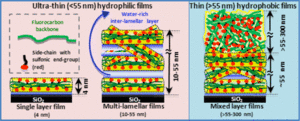
Nafion is a sulfonated tetrafluoroethylene based fluoropolymer-copolymer, which is being studied here for use in a proton conductor for proton exchange membrane (PEM) fuel cells because of its excellent thermal and mechanical stability.
Abstract[edit | edit source]
Self-assembled Nafion films of varying thickness were generated on SiO2 terminated silicon wafer by immersion in Nafion dispersions of different concentrations. The impact of solvent/dispersion media was probed by preparing films from two different types of Nafion dispersions—IPA-diluted dispersion and Nafion-in-water dispersion. The thickness of films was ascertained by three different techniques: variable angle spectroscopic ellipsometry (VASE), atomic force microscopy (AFM), and X-ray photoelectron spectroscopy (XPS). The three techniques yielded consistent nominal thicknesses of 4, 10, 30, 55, 75, 110, 160, and 300 nm for films self-assembled from IPA-diluted Nafion dispersions of concentrations 0.1, 0.25, 0.5, 1.0, 1.5, 2.0, 3.0, and 5.0 wt %, respectively. Films generated from 0.25–5.0 wt % Nafion-in-water dispersions generated comparable thicknesses. An interesting finding of our work is the observation of bimodal surface wettability, investigated by water contact angle. The sub-55 nm films were found to exhibit hydrophilic surface whereas the thicker films showed hydrophobic surface similar to those reported for Nafion membranes. Employing XDLVO theory, surface energies of the hydrophobic, 160 nm film was found to be similar to that reported for Nafion membrane whereas those for the hydrophilic 4 nm film yielded high electron-accepting/proton-donating parameters resulting in an enhanced surface polarity. It can be concluded that the structure and properties of the ultrathin (<55 nm) Nafion films are distinct from those of the thicker (but still submicrometer) films, which are likely similar to those of the well-studied Nafion membranes. No significant effect of dispersion type was observed for 10–300 nm thick films.

